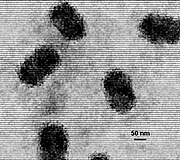Molluscum contagiosum virus
| Molluscum contagiosum virus | |
|---|---|

| |
| EM of Molluscum contagiosum virus | |
| Virus classification | |
| Group: | Group I (dsDNA)
|
| Family: | |
| Genus: | Molluscipoxvirus
|
| Species: | Molluscum contagiosum virus
|
The Molluscum contagiosum virus or MCV is a species of virus in the poxvirus family, which causes the disease Molluscum contagiosum in humans. Virions have a complex structure and is consistent with the structure of the poxvirus family: an envelope, surface membrane, core, and lateral bodies. Virus may be contained within inclusion bodies and mature by budding through the membrane of the host cell giving rise to a large amount of viral shedding in a short period of time. Approximate measurements of the virus are 200 nm in diameter, 320 nm in length and 100 nm in height.[1]

Diagnosis is made on the clinical appearance; the virus cannot routinely be cultured. The diagnosis can be confirmed by excisional biopsy. There are 4 types of MCV, MCV-1 to -4. MCV-1 is the most prevalent in human infections,[2] and MCV-2 seen usually in adults and often sexually transmitted.[3][4] Polymerase chain reaction techniques are being developed to help confirm lesions as being caused by MCV,[5] and distinguish between strains.[6][7]
Genome
The genome is a non-segmented single molecule of linear, double-stranded DNA of 180000–200000 nucleotides. It is covalently linked at both ends and contain redundant, repeating sequences at both ends. 160 putative genes have been identified.[8]
Footnotes
- ^ Büchen-Osmond, C. (Ed) (2003). 00.058.1.07.001. Molluscum contagiosum virus. In: ICTVdB - The Universal Virus Database, version 3. Büchen-Osmond, C. (Ed), ICTVdB Management, Columbia University, New York, USA
- ^ Porter CD, Muhlemann MF, Cream JJ, Archard LC (1987). "Molluscum contagiosum: characterization of viral DNA and clinical features". Epidemiol. Infect. 99 (2): 563–7. doi:10.1017/S0950268800068072. PMC 2249301. PMID 2824227.
{{cite journal}}: CS1 maint: multiple names: authors list (link) - ^ Yamashita H, Uemura T, Kawashima M (1996). "Molecular epidemiologic analysis of Japanese patients with molluscum contagiosum". Int. J. Dermatol. 35 (2): 99–105. doi:10.1111/j.1365-4362.1996.tb03270.x. PMID 8850036.
{{cite journal}}: CS1 maint: multiple names: authors list (link) - ^ Agromayor M, Ortiz P, Lopez-Estebaranz JL, Gonzalez-Nicolas J, Esteban M, Martin-Gallardo A (2002). "Molecular epidemiology of molluscum contagiosum virus and analysis of the host-serum antibody response in Spanish HIV-negative patients". J. Med. Virol. 66 (2): 151–8. doi:10.1002/jmv.2124. PMID 11782922.
{{cite journal}}: CS1 maint: multiple names: authors list (link) - ^ Nuñez A, Funes JM, Agromayor M; et al. (1996). "Detection and typing of molluscum contagiosum virus in skin lesions by using a simple lysis method and polymerase chain reaction". J. Med. Virol. 50 (4): 342–9. doi:10.1002/(SICI)1096-9071(199612)50:4<342::AID-JMV10>3.0.CO;2-K. PMID 8950692.
{{cite journal}}: Explicit use of et al. in:|author=(help)CS1 maint: multiple names: authors list (link) - ^ Thompson CH (1997). "Identification and typing of molluscum contagiosum virus in clinical specimens by polymerase chain reaction". J. Med. Virol. 53 (3): 205–11. doi:10.1002/(SICI)1096-9071(199711)53:3<205::AID-JMV4>3.0.CO;2-C. PMID 9365883.
- ^ Trama JP, Adelson ME, Mordechai E (2007). "Identification and genotyping of molluscum contagiosum virus from genital swab samples by real-time PCR and Pyrosequencing". J Clin Virol. 40 (4): 325. doi:10.1016/j.jcv.2007.09.007. PMID 17997134.
{{cite journal}}: CS1 maint: multiple names: authors list (link) - ^ Thompson CH (1999). "Molluscum contagiosum: new perspectives on an old virus". Curr. Opin. Infect. Dis. 12 (3): 185–9. PMID 17035777.
